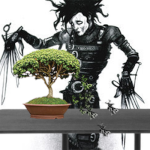Azalea ID needed
5 posters
Page 1 of 1
 Azalea ID needed
Azalea ID needed
We were at Costco 2 weeks ago and this Azalea jumped in our cart. For me it was a no brainer for $8.95. My wife loved it and she said I can have it for bonsai once the flowers fall. I think the flowers are good for bonsai since it is a lot smaller than the other ones they have. Can anyone help ID which variety this is?
Thank you.



Thank you.




Poink88- Member
 Re: Azalea ID needed
Re: Azalea ID needed
Dario, maybe 'pink pearl'. Was there anything telling you which grower it came from? The problem is that there are many azaleas grown in the north and shipped south (and vice versa) to stores like this that aren't really good in our heat and humidity.

Russell Coker- Member
 Re: Azalea ID needed
Re: Azalea ID needed
Russell,
I checked the pics online of pink pearl and it didn't match. While there I stumbled on a more likely match. It is Kurume "Blaauw's Pink" as shown here http://www.learn2grow.com/plants/rhododendron-blaauws-pink/ almost a perfect match but I am not sure.
I will check the tags better tomorrow and see if I can find more info. Thank you.
I checked the pics online of pink pearl and it didn't match. While there I stumbled on a more likely match. It is Kurume "Blaauw's Pink" as shown here http://www.learn2grow.com/plants/rhododendron-blaauws-pink/ almost a perfect match but I am not sure.
I will check the tags better tomorrow and see if I can find more info. Thank you.

Poink88- Member
 reply
reply
flowers are very beautiful. If a new purchase, you need to plant in new soil, because the previous owner has a lot of stimulant harmful to the tree. I often do that with the new purchase of tree
My tree

My tree


tap pi lu- Member
 Re: Azalea ID needed
Re: Azalea ID needed
Poink88 wrote:Russell,
I checked the pics online of pink pearl and it didn't match. While there I stumbled on a more likely match. It is Kurume "Blaauw's Pink" as shown here http://www.learn2grow.com/plants/rhododendron-blaauws-pink/ almost a perfect match but I am not sure.
I will check the tags better tomorrow and see if I can find more info. Thank you.
That's a good match, I certainly wouldn't argue against it. I'm not familiar with this Kurume at all. My azalea growing friends here produce only a select few Kurumes because there are just so many azaleas better suited for the gulf south.

Russell Coker- Member
 Re: Azalea ID needed
Re: Azalea ID needed
Glaucus,Glaucus wrote:http://www.pbase.com/azaleasociety/image/57540453
Thanks, that does match what I found online. What sets this apart from the other azaleas I've seen is the thicker flower. It is not flimsy and paper-like as most have.

Poink88- Member
 Re: Azalea ID needed
Re: Azalea ID needed
Russell,Russell Coker wrote:That's a good match, I certainly wouldn't argue against it. I'm not familiar with this Kurume at all. My azalea growing friends here produce only a select few Kurumes because there are just so many azaleas better suited for the gulf south.
I am hoping it is Kurume Blaauw's Pink since it is supposed to be rated for zone 6-9.
I've been reading the other azalea thread but noted that one behaves differently from Kurume. Any tips in developing the trunk of this one?

Poink88- Member
 Re: Azalea ID needed
Re: Azalea ID needed
Thank you. As soon as the flowers wilt/fall, I will re-pot this and start trunk development (I hope).tap pi lu wrote:flowers are very beautiful. If a new purchase, you need to plant in new soil, because the previous owner has a lot of stimulant harmful to the tree. I often do that with the new purchase of tree

Poink88- Member
 Re: Azalea ID needed
Re: Azalea ID needed
I think you'll find that ALL Kurumes are rated for zones 6 - 9. The problem (if you can call it that) is they are happier in 6, but that's not to say Kurumes won't grow here.
My friend said 'Blaauw's pink' was popular with growers back in the 1960's but was hard to find around here by the mid 1970's. I do see mysterious pink Kurumes in older parts of town, I'll have to pay for attention to them.

Russell Coker- Member
 Re: Azalea ID needed
Re: Azalea ID needed
It looks like you have more than one plant in this pot. Grower will usually root a number of cuttings together to give themselves a quicker salable plant.

Billy M. Rhodes- Member
 Re: Azalea ID needed
Re: Azalea ID needed
Very possible Billy and I am hoping actually. I will know when I explore below current soil line in a few weeks or so. Thanks!Billy M. Rhodes wrote:It looks like you have more than one plant in this pot. Grower will usually root a number of cuttings together to give themselves a quicker salable plant.

Poink88- Member
 Re: Azalea ID needed
Re: Azalea ID needed
I saw a lot of 'Baauw's Pink' at garden centers here last year. It's a Dutch cultivar after all, but quite old. I see a lot more Geisha series hybrids this year.
Rooting multiple cuttings in the same pot I see often for florist azalea, less for garden material. I do think they do prune the single cutting plants to make it even more multibranched than it naturally would grow. But in the end hybrid growth habit plays a big role as well in how it turns out.
How exactly to grow trunks and when to cut sacrificial branches, I would like to know as well. One important thing may be to know how well it backbud on old wood. With some no matter how old you can grow the lowest branch from scratch, it seems. With others you have to figure out what will be a final branch, which branches can still thicken to help trunk taper and which branches are too thick and need to go to prevent bad-looking taper or reverse taper.
I think from memory the leaves of 'Blaauw's Pink' looks a bitmore like R.kaempferi than more true R.kiusianum hybrids. Of course kurume hybirds are those that are really mixed in parentage.
Here in Europe the Hachmann family business is really doing some advanced breeding. They keep hybridizing with the newer hybrids as well. They don't use satsuki but recently they started using some of Cox R.nakaharae hybrids after Cox got some American North Tisbury.
Rooting multiple cuttings in the same pot I see often for florist azalea, less for garden material. I do think they do prune the single cutting plants to make it even more multibranched than it naturally would grow. But in the end hybrid growth habit plays a big role as well in how it turns out.
How exactly to grow trunks and when to cut sacrificial branches, I would like to know as well. One important thing may be to know how well it backbud on old wood. With some no matter how old you can grow the lowest branch from scratch, it seems. With others you have to figure out what will be a final branch, which branches can still thicken to help trunk taper and which branches are too thick and need to go to prevent bad-looking taper or reverse taper.
I think from memory the leaves of 'Blaauw's Pink' looks a bitmore like R.kaempferi than more true R.kiusianum hybrids. Of course kurume hybirds are those that are really mixed in parentage.
Here in Europe the Hachmann family business is really doing some advanced breeding. They keep hybridizing with the newer hybrids as well. They don't use satsuki but recently they started using some of Cox R.nakaharae hybrids after Cox got some American North Tisbury.
Glaucus- Member
 Re: Azalea ID needed
Re: Azalea ID needed
From here http://www.bonsai4me.com/SpeciesGuide/Rhododendron.html
"The two principal Azalea species that are used for bonsai are Satsuki azaleas and Kurume azaleas though there are many other Azalea species and hybrids that are suitable and these should not be discounted as potential bonsai material. All Rhododendron species have the ability to withstand root pruning and all will back-bud with ease."
"KURUME AZALEAS
Kurume hybrids are Japanese-raised Azaleas originating from crosses between R. kaempferi (which were originally Dutch bred), R.kiusianum and R.obtusum. Kurume hybrids are hardier than Satsukis and produce numerous, very small, funnel shaped flowers in a wide range of colours in Spring."
"PRUNING Azaleas/Rhododendrons are basally dominant which means they grow more strongly at the base and sides than at the top; for this reason (unlike most other species used for bonsai) they should be pruned much harder at the bottom and sides than the top."
"The two principal Azalea species that are used for bonsai are Satsuki azaleas and Kurume azaleas though there are many other Azalea species and hybrids that are suitable and these should not be discounted as potential bonsai material. All Rhododendron species have the ability to withstand root pruning and all will back-bud with ease."
"KURUME AZALEAS
Kurume hybrids are Japanese-raised Azaleas originating from crosses between R. kaempferi (which were originally Dutch bred), R.kiusianum and R.obtusum. Kurume hybrids are hardier than Satsukis and produce numerous, very small, funnel shaped flowers in a wide range of colours in Spring."
"PRUNING Azaleas/Rhododendrons are basally dominant which means they grow more strongly at the base and sides than at the top; for this reason (unlike most other species used for bonsai) they should be pruned much harder at the bottom and sides than the top."

Poink88- Member
 Re: Azalea ID needed
Re: Azalea ID needed
R.kaempferi is a species in Japan. Japanese kurume hybrids have nothing to do with Dutch breeding besides that also in the Netherlands Japanese kurume arrived and then domestic breeding followed.
R.obtusum is a general term for R.kaempferi, R.kiusianum, kurume hybrids, kirishima hybrids, edo-kirishima hybrids, R.sataense(population that is though to be a natural hyrid of R.kuisianum and R.kaempferi), R.komiyamae (don't even know what it is exactly except it is part of the obtusum group) and R.tosaense (natural hybrid of already a new species?).
The Dutch started out azalea breeding and they used R.kaempferi or R.kaempferi type plants. Later they also got kurume cultivar after the world expo in Panama showed some to western garderners and Wilson and the Domoto brothers.
Nature does it's own hybridization and doesn't respect human-defined species barriers. Then you enter the arena of the lumpers and splitters debate.
The Japanese created many strains of kurume hybrids for their temple gardens, along with the much larger flowering Hirado azalea. Satsuki were created for potted plants and later bonsai.
R.obtusum is a general term for R.kaempferi, R.kiusianum, kurume hybrids, kirishima hybrids, edo-kirishima hybrids, R.sataense(population that is though to be a natural hyrid of R.kuisianum and R.kaempferi), R.komiyamae (don't even know what it is exactly except it is part of the obtusum group) and R.tosaense (natural hybrid of already a new species?).
The Dutch started out azalea breeding and they used R.kaempferi or R.kaempferi type plants. Later they also got kurume cultivar after the world expo in Panama showed some to western garderners and Wilson and the Domoto brothers.
Nature does it's own hybridization and doesn't respect human-defined species barriers. Then you enter the arena of the lumpers and splitters debate.
The Japanese created many strains of kurume hybrids for their temple gardens, along with the much larger flowering Hirado azalea. Satsuki were created for potted plants and later bonsai.
Glaucus- Member
 Similar topics
Similar topics» Thick, swollen tips on azalea leaves - Azalea Leaf Gall
» Is this a Satsuki Azalea or other azalea?
» ID needed....
» Bonsai Artworks merry Christmas to all
» Hemlock Help Needed
» Is this a Satsuki Azalea or other azalea?
» ID needed....
» Bonsai Artworks merry Christmas to all
» Hemlock Help Needed
Page 1 of 1
Permissions in this forum:
You cannot reply to topics in this forum






